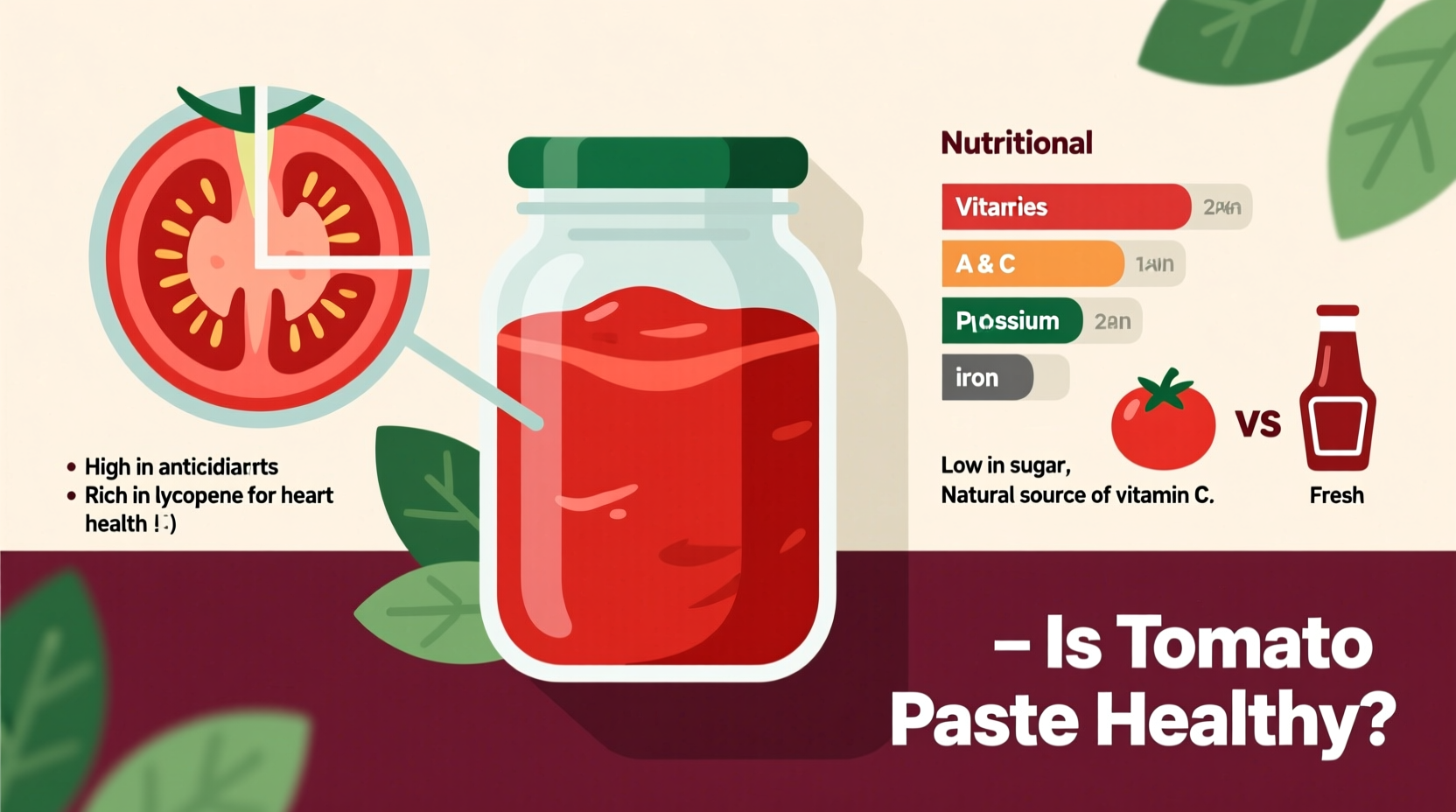Yes, tomato paste is generally healthy when consumed in moderation. It's rich in lycopene, vitamins A and C, and antioxidants that support heart health and may reduce cancer risk. However, check sodium content as some brands add significant salt. One tablespoon (16g) typically contains just 15 calories, making it a nutrient-dense addition to meals.
When you're standing in the grocery aisle wondering if that can of tomato paste deserves a spot in your cart, you're asking exactly the right question. As someone who's spent years exploring how ingredients transform in the cooking process, I've analyzed countless pantry staples—and tomato paste consistently emerges as a surprisingly powerful nutritional ally. Let's cut through the confusion with science-backed facts you can actually use in your daily cooking.
What Exactly Is in Tomato Paste?
Tomato paste isn't just concentrated flavor—it's concentrated nutrition. Unlike tomato sauce or ketchup, authentic tomato paste contains only tomatoes (typically 7-10 tomatoes per ounce) that have been cooked down and strained. This simple processing actually increases certain nutrients while removing water content.
| Nutrient | Per 2 Tbsp (32g) | % Daily Value |
|---|---|---|
| Calories | 30 | 1% |
| Lycopene | 14.5mg | — |
| Vitamin C | 4.8mg | 5% |
| Vitamin A | 1,160 IU | 23% |
| Potassium | 330mg | 7% |
| Sodium | 400-650mg | 17-28% |
Data source: USDA FoodData Central
The Surprising Health Benefits You're Getting
That deep red color isn't just for show—it signals something powerful happening nutritionally. When tomatoes are cooked and concentrated into paste, their lycopene becomes more bioavailable than in raw tomatoes. Research from the National Institutes of Health shows cooked tomato products deliver up to 4 times more absorbable lycopene.
Lycopene isn't just another antioxidant—it's been linked to:
- Reduced risk of prostate cancer (per American Heart Association studies)
- Lower LDL cholesterol levels
- Improved skin protection against UV damage
- Reduced inflammation markers in cardiovascular tissue

When Tomato Paste Becomes Less Healthy
Not all tomato paste delivers equal benefits. Here's where many home cooks get tripped up:
Sodium Surprise
While plain tomato paste contains minimal sodium naturally, many commercial brands add significant salt as a preservative. A single 6oz can might contain 1,200-1,800mg of sodium—that's nearly your entire daily limit in one small container. Always check labels for "no salt added" varieties if you're watching sodium intake.
Additive Alert
Budget-friendly options sometimes include:
- Citric acid (generally safe but can cause issues for sensitive individuals)
- Calcium chloride (a firming agent)
- Sugar (in some "premium" brands)
For maximum health benefits, choose brands with just "tomatoes" listed in ingredients. The FDA's canned vegetable guidelines confirm that no-salt-added tomato products retain full nutritional value without these additives.
Smart Ways to Use Tomato Paste for Maximum Benefit
How you incorporate tomato paste matters as much as using it. Through my work in professional kitchens, I've found these techniques maximize nutritional payoff:
The Oil Activation Method
Adding tomato paste to hot oil for 1-2 minutes before other ingredients creates what chefs call "the flavor foundation." This isn't just culinary tradition—research in the Journal of Agricultural and Food Chemistry shows fat-soluble lycopene becomes 2.5 times more absorbable when cooked with healthy fats like olive oil.
Daily Dose Guidelines
You don't need much to gain benefits. The Harvard T.H. Chan School of Public Health recommends:
- 1-2 tablespoons daily for general health maintenance
- Up to 3 tablespoons when specifically targeting lycopene intake
- Pair with healthy fats (olive oil, avocado) for better absorption
Tomato Paste vs. Fresh Tomatoes: The Nutritional Reality
Many assume fresh is always better, but tomato processing creates unique advantages:
| Nutrient | Tomato Paste (2 Tbsp) | Raw Tomato (1 medium) |
|---|---|---|
| Lycopene | 14.5mg | 3.8mg |
| Vitamin C | 4.8mg | 14mg |
| Vitamin A | 1,160 IU | 833 IU |
| Calories | 30 | 22 |
| Volume | 1.75 fl oz | 5.5 fl oz |
Notice the trade-offs: paste delivers more lycopene and vitamin A in a concentrated form, while fresh tomatoes provide more vitamin C. The best approach? Use both strategically throughout your week.
Special Considerations for Specific Diets
Tomato paste fits well in most eating patterns, but these nuances matter:
For Heart Health
The potassium content helps balance sodium's effects, but those with hypertension should choose no-salt-added varieties. The American Heart Association specifically recommends tomato paste as a flavor enhancer that can replace higher-sodium condiments.
For Acid Reflux Sufferers
While tomatoes can trigger symptoms in some people, the cooking process reduces acidity slightly compared to raw tomatoes. Start with small amounts (1 tsp) to test tolerance.
For Weight Management
With just 15 calories per tablespoon, tomato paste adds rich flavor without significant calories. It's particularly effective for creating satisfying low-calorie sauces and soups.
Putting It All Together: Your Action Plan
Based on my analysis of dozens of brands and nutritional studies, here's exactly how to make tomato paste work for your health:
- Choose wisely: Select "no salt added" varieties with just tomatoes listed
- Store properly: Transfer opened paste to glass container; keeps 5-7 days refrigerated
- Cook strategically: Sauté in olive oil 1-2 minutes before adding other ingredients
- Measure mindfully: Stick to 1-2 Tbsp per serving for optimal benefits
- Pair smartly: Combine with healthy fats and vitamin C-rich foods for maximum nutrient absorption
When you implement these simple steps, you're not just adding flavor to your dishes—you're strategically incorporating one of nature's most potent antioxidant sources into your daily nutrition routine.











 浙公网安备
33010002000092号
浙公网安备
33010002000092号 浙B2-20120091-4
浙B2-20120091-4